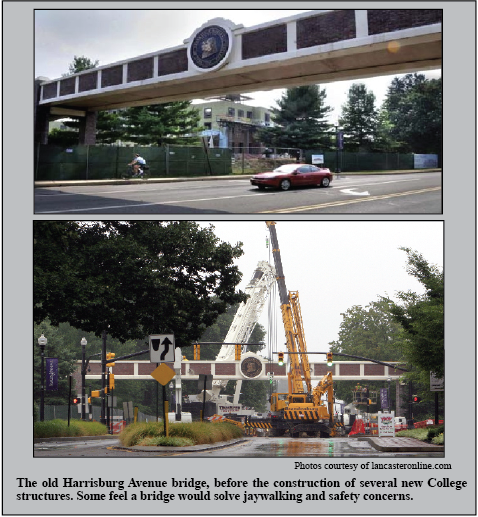By Scott Onigman II Senior Editor
The bridge that used to span Harrisburg Avenue is a long gone memory of the F&M campus aesthetic and infrastructure.
I have never inquired as to why the bridge was taken down in 2010, I can imagine there were numerous positive reasons to do so, but this lack of inquiry leads to a contemporary argument to “bring the bridge back.”
I have only recently seen photos of what the bridge looked like. It looked quite historic, but in a very different manner than the Armstrong footbridge that is due to come down behind College Row. This structure which spanned Harrisburg Pike greeted any travelers along the pike to F&M and served as a signal to the history of the campus.
The view along this part of Harrisburg Pike is very different today; the right side of the road going towards the city center is flanked by New College House.
The other side of the street has not changed since the bridge came down, College Square is still in active use and College Row at Campus Crossings is well populated. This final part makes tearing down the bridge very confusing — if there was going to be more traffic to the other side of Harrisburg pike than anytime in the College’s history before that, why take down an edifice that made transit easier and safer?
Many students, faculty, professional staff, and community members have voiced concerns about safety of crossing Harrisburg Pike due to the high volume of traffic that flows along this key artery of the city.
What complicates the issue of safety on Harrisburg Pike is the layout of the intersection. Students who live in College Row frequently jaywalk across Harrisburg Pike. Many students do this cognizant of the risk that they are taking; due to the timing of the light that makes it possible for pedestrians to cross, there is tremendous time incentive, especially during the cold winter months to jaywalk when there is no walk signal, and even to not cross in the cross walk, never mind whether the lights are green, yellow, or red.
The goal of this article is not to condone jaywalking, of course. But that being said, if there are very few cars coming, the incentives to cross and not wait in bitter temperatures are high and many students and other community members may decide to jaywalk. It might just happen.
Restoring the bridge is a possible solution to this jaywalking and traffic safety problem; another solution lies in changing the traffic flow of the intersection so that it is easier to walk from the space between the two College Row buildings directly to the sidewalk adjacent to the Sponaugle-Williamson Field. This may entail putting in a stop sign in order to attain the necessary precautions from the traffic flow.
Though this solution seems to resolve the jaywalking solution, it doesn’t change the risk of crossing Harrisburg Pike. It may be that changing the traffic flow around this area, including the addition of a stop sign would anger drivers going in both directions, and be risky for students and other community members crossing the street if the traffic (ideally a stop, and if possible a caution) signs are not followed — therefore, this plan may exacerbate the jaywalking safety issue.
There are also downsides to erecting a pedestrian bridge across Harrisburg Pike. First and foremost, it would be expensive and would create traffic problems around an area of Lancaster that already has congestion during week-day rush hour.
Second, community members and students may also decide to ignore taking the bridge and to jaywalk because it is faster, though riskier — and this plan would be all for nought.
Finally, and most abstractly, building a bridge for students and community members to travel over the traffic may send a negative message to the Lancaster community — one that may be interpreted as placing F&M students and community members above those of the city and local region. Rebuilding the bridge may exacerbate tensions between those who think F&M students are pretentious.
Though this is speaks to an aforementioned abstract vision, the social construct put in place by this physical construct is one I find most deterring in the construction of the bridge.
At a time when the F&M community has made great steps to be included and integrated within the greater Lancaster community, this may set the school back a few steps and undo the progress that was made by taking down the original bridge. Perhaps the campus is again ready to have a discussion about the bridge.
